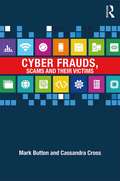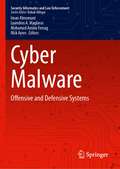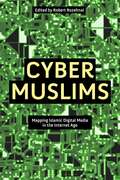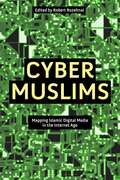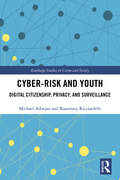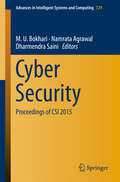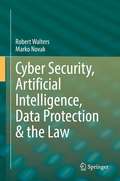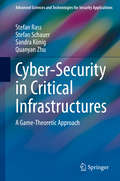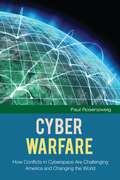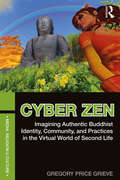- Table View
- List View
Cyber Frauds, Scams and their Victims
by Mark Button Cassandra CrossCrime is undergoing a metamorphosis. The online technological revolution has created new opportunities for a wide variety of crimes which can be perpetrated on an industrial scale, and crimes traditionally committed in an offline environment are increasingly being transitioned to an online environment. This book takes a case study-based approach to exploring the types, perpetrators and victims of cyber frauds. Topics covered include: An in-depth breakdown of the most common types of cyber fraud and scams. The victim selection techniques and perpetration strategies of fraudsters. An exploration of the impact of fraud upon victims and best practice examples of support systems for victims. Current approaches for policing, punishing and preventing cyber frauds and scams. This book argues for a greater need to understand and respond to cyber fraud and scams in a more effective and victim-centred manner. It explores the victim-blaming discourse, before moving on to examine the structures of support in place to assist victims, noting some of the interesting initiatives from around the world and the emerging strategies to counter this problem. This book is essential reading for students and researchers engaged in cyber crime, victimology and international fraud.
Cyber Ireland: Text, Image, Culture
by C. LynchCyber Ireland explores, for the first time, the presence and significance of cyberculture in Irish literature. Bringing together such varied themes as Celtic mythology in video games, Joycean hypertexts and virtual reality Irish tourism, the book introduces a new strand of Irish studies for the twenty-first century.
Cyber Justice: Human Rights and Good Governance for the Internet (SpringerBriefs in Political Science)
by Anja MihrThis book introduces Cyber Justice as a viable approach for promoting good governance based on human rights norms in the internet. The author defines cyberspace as a borderless public space without common rules or government control mechanisms that protect and foster people’s activities within that space. In light of the growing scope of communications and interactions in the internet, the author shows how human rights and governance regimes can be adapted to cyberspace in order to ensure more accountability, transparency and interaction among those who use the internet and those who manage and provide internet services. This book will be of interest for scholars and policymakers interested in establishing governance regimes for cyberspace that will enjoy the support and trust of all users.
Cyber Malware: Offensive and Defensive Systems (Security Informatics and Law Enforcement)
by Iman Almomani Leandros A. Maglaras Mohamed Amine Ferrag Nick AyresThis book provides the foundational aspects of malware attack vectors and appropriate defense mechanisms against malware. The book equips readers with the necessary knowledge and techniques to successfully lower the risk against emergent malware attacks. Topics cover protections against malware using machine learning algorithms, Blockchain and AI technologies, smart AI-based applications, automated detection-based AI tools, forensics tools, and much more. The authors discuss theoretical, technical, and practical issues related to cyber malware attacks and defense, making it ideal reading material for students, researchers, and developers.
Cyber Muslims: Mapping Islamic Digital Media in the Internet Age
by Robert RozehnalThrough an array of detailed case studies, this book explores the vibrant digital expressions of diverse groups of Muslim cybernauts: religious clerics and Sufis, feminists and fashionistas, artists and activists, hajj pilgrims and social media influencers. These stories span a vast cultural and geographic landscape-from Indonesia, Iran, and the Arab Middle East to North America. These granular case studies contextualize cyber Islam within broader social trends: racism and Islamophobia, gender dynamics, celebrity culture, identity politics, and the shifting terrain of contemporary religious piety and practice. The book's authors examine an expansive range of digital multimedia technologies as primary “texts.” These include websites, podcasts, blogs, Twitter, Facebook, Instagram, YouTube channels, online magazines and discussion forums, and religious apps. The contributors also draw on a range of methodological and theoretical models from multiple academic disciplines, including communication and media studies, anthropology, history, global studies, religious studies, and Islamic studies.
Cyber Muslims: Mapping Islamic Digital Media in the Internet Age
Through an array of detailed case studies, this book explores the vibrant digital expressions of diverse groups of Muslim cybernauts: religious clerics and Sufis, feminists and fashionistas, artists and activists, hajj pilgrims and social media influencers. These stories span a vast cultural and geographic landscape-from Indonesia, Iran, and the Arab Middle East to North America. These granular case studies contextualize cyber Islam within broader social trends: racism and Islamophobia, gender dynamics, celebrity culture, identity politics, and the shifting terrain of contemporary religious piety and practice. The book's authors examine an expansive range of digital multimedia technologies as primary “texts.” These include websites, podcasts, blogs, Twitter, Facebook, Instagram, YouTube channels, online magazines and discussion forums, and religious apps. The contributors also draw on a range of methodological and theoretical models from multiple academic disciplines, including communication and media studies, anthropology, history, global studies, religious studies, and Islamic studies.
Cyber-Physical Attacks: A Growing Invisible Threat
by George LoukasCyber-Physical Attacks: A Growing Invisible Threat presents the growing list of harmful uses of computers and their ability to disable cameras, turn off a building's lights, make a car veer off the road, or a drone land in enemy hands. In essence, it details the ways cyber-physical attacks are replacing physical attacks in crime, warfare, and terrorism. The book explores how attacks using computers affect the physical world in ways that were previously only possible through physical means. Perpetrators can now cause damage without the same risk, and without the political, social, or moral outrage that would follow a more overt physical attack. Readers will learn about all aspects of this brave new world of cyber-physical attacks, along with tactics on how to defend against them. The book provides an accessible introduction to the variety of cyber-physical attacks that have already been employed or are likely to be employed in the near future. - Demonstrates how to identify and protect against cyber-physical threats - Written for undergraduate students and non-experts, especially physical security professionals without computer science background - Suitable for training police and security professionals - Provides a strong understanding of the different ways in which a cyber-attack can affect physical security in a broad range of sectors - Includes online resources for those teaching security management
Cyber-Physical Systems Security
by Çetin Kaya KoçThe chapters in this book present the work of researchers, scientists, engineers, and teachers engaged with developing unified foundations, principles, and technologies for cyber-physical security. They adopt a multidisciplinary approach to solving related problems in next-generation systems, representing views from academia, government bodies, and industrial partners, and their contributions discuss current work on modeling, analyzing, and understanding cyber-physical systems.
Cyber Racism and Community Resilience: Strategies for Combating Online Race Hate
by Andrew Jakubowicz Kevin Dunn Gail Mason Yin Paradies Ana-Maria Bliuc Nasya Bahfen Andre Oboler Rosalie Atie Karen ConnellyThis book highlights cyber racism as an ever growing contemporary phenomenon. Its scope and impact reveals how the internet has escaped national governments, while its expansion is fuelling the spread of non-state actors. In response, the authors address the central question of this topic: What is to be done? Cyber Racism and Community Resilience demonstrates how the social sciences can be marshalled to delineate, comprehend and address the issues raised by a global epidemic of hateful acts against race. Authored by an inter-disciplinary team of researchers based in Australia, this book presents original data that reflects upon the lived, complex and often painful reality of race relations on the internet. It engages with the various ways, from the regulatory to the role of social activist, which can be deployed to minimise the harm often felt. This book will be of particular interest to students and academics in the fields of cybercrime, media sociology and cyber racism.
Cyber Racism and Community Resilience: Strategies for Combating Online Race Hate
by Andrew Jakubowicz Kevin Dunn Gail Mason Yin Paradies Ana-Maria Bliuc Nasya Bahfen Andre Oboler Rosalie Atie Karen ConnellyThis book highlights cyber racism as an ever growing contemporary phenomenon. Its scope and impact reveals how the internet has escaped national governments, while its expansion is fuelling the spread of non-state actors. In response, the authors address the central question of this topic: What is to be done? Cyber Racism and Community Resilience demonstrates how the social sciences can be marshalled to delineate, comprehend and address the issues raised by a global epidemic of hateful acts against race. Authored by an inter-disciplinary team of researchers based in Australia, this book presents original data that reflects upon the lived, complex and often painful reality of race relations on the internet. It engages with the various ways, from the regulatory to the role of social activist, which can be deployed to minimise the harm often felt. This book will be of particular interest to students and academics in the fields of cybercrime, media sociology and cyber racism.
Cyber-risk and Youth: Digital Citizenship, Privacy and Surveillance (Routledge Studies in Crime and Society)
by Michael C Adorjan Rosemary RicciardelliCyber-risks are moving targets and societal responses to combat cyber-victimization are often met by the distrust of young people. Drawing on original research, this book explores how young people define, perceive, and experience cyber-risks, how they respond to both the messages they are receiving from society regarding their safety online, and the various strategies and practices employed by society in regulating their online access and activities. This book complements existing quantitative examinations of cyberbullying assessing its extent and frequency, but also aims to critique and extend knowledge of how cyber-risks such as cyberbullying are perceived and responded to. Following a discussion of their methodology and their experiences of conducting research with teens, the authors discuss the social network services that teens are using and what they find appealing about them, and address teens’ experiences with and views towards parental and school-based surveillance. The authors then turn directly to areas of concern expressed by their participants, such as relational aggression, cyberhacking, privacy, and privacy management, as well as sexting. The authors conclude by making recommendations for policy makers, educators and teens – not only by drawing from their own theoretical and sociological interpretations of their findings, but also from the responses and recommendations given by their participants about going online and tackling cyber-risk. One of the first texts to explore how young people respond to attempts to regulate online activity, this book will be key reading for those involved in research and study surrounding youth crime, cybercrime, youth culture, media and crime, and victimology – and will inform those interested in addressing youth safety online how to best approach what is often perceived as a sensitive and volatile social problem.
Cyber-risk and Youth: Digital Citizenship, Privacy and Surveillance (Routledge Studies in Crime and Society)
by Michael C Adorjan Rosemary RicciardelliCyber-risks are moving targets and societal responses to combat cyber-victimization are often met by the distrust of young people. Drawing on original research, this book explores how young people define, perceive, and experience cyber-risks, how they respond to both the messages they are receiving from society regarding their safety online, and the various strategies and practices employed by society in regulating their online access and activities. This book complements existing quantitative examinations of cyberbullying assessing its extent and frequency, but also aims to critique and extend knowledge of how cyber-risks such as cyberbullying are perceived and responded to. Following a discussion of their methodology and their experiences of conducting research with teens, the authors discuss the social network services that teens are using and what they find appealing about them, and address teens’ experiences with and views towards parental and school-based surveillance. The authors then turn directly to areas of concern expressed by their participants, such as relational aggression, cyberhacking, privacy, and privacy management, as well as sexting. The authors conclude by making recommendations for policy makers, educators and teens – not only by drawing from their own theoretical and sociological interpretations of their findings, but also from the responses and recommendations given by their participants about going online and tackling cyber-risk. One of the first texts to explore how young people respond to attempts to regulate online activity, this book will be key reading for those involved in research and study surrounding youth crime, cybercrime, youth culture, media and crime, and victimology – and will inform those interested in addressing youth safety online how to best approach what is often perceived as a sensitive and volatile social problem.
Cyber Security: Proceedings of CSI 2015 (Advances in Intelligent Systems and Computing #729)
by M. U. Bokhari Namrata Agrawal Dharmendra SainiThis book comprises select proceedings of the annual convention of the Computer Society of India. Divided into 10 topical volumes, the proceedings present papers on state-of-the-art research, surveys, and succinct reviews. The volume covers diverse topics ranging from information security to cryptography and from encryption to intrusion detection. This book focuses on Cyber Security. It aims at informing the readers about the technology in general and the internet in particular. The book uncovers the various nuances of information security, cyber security and its various dimensions. This book also covers latest security trends, ways to combat cyber threats including the detection and mitigation of security threats and risks. The contents of this book will prove useful to professionals and researchers alike.
Cyber Security: Critical Infrastructure Protection (Computational Methods in Applied Sciences #56)
by Martti Lehto Pekka NeittaanmäkiThis book focus on critical infrastructure protection. The chapters present detailed analysis of the issues and challenges in cyberspace and provide novel solutions in various aspects. The first part of the book focus on digital society, addressing critical infrastructure and different forms of the digitalization, strategic focus on cyber security, legal aspects on cyber security, citizen in digital society, and cyber security training. The second part focus on the critical infrastructure protection in different areas of the critical infrastructure. The chapters cover the cybersecurity situation awareness, aviation and air traffic control, cyber security in smart societies and cities, cyber security in smart buildings, maritime cyber security, cyber security in energy systems, and cyber security in healthcare. The third part presents the impact of new technologies upon cyber capability building as well as new challenges brought about by new technologies. These new technologies are among others are quantum technology, firmware and wireless technologies, malware analysis, virtualization.
Cyber Security and Social Media Applications (Lecture Notes in Social Networks)
by Sibel Tarıyan Özyer Buket KayaThis book offers an excellent source of knowledge for readers who are interested in keeping up with the developments in the field of cyber security and social media analysis. It covers the possibility of using augmented reality to monitor cyber security feeds in a multitasking environment. It describes a real-time scheduled security scanner. E-commerce concept labeling is tackled by introducing a lightweight global taxonomy induction system. Blogsphere analytics and online video narratives and networks are explored. The effect of global and local network structure, credibility based prevention of fake news dissemination, and detection of trending topics and influence from social media are investigated.This book helps the reader in developing their own perspective about how to deal with cyber security and how to benefit from the development in technology to tackle cyber security issues. The reader of this book will realize how to use various machine learning techniques for tackling various applications involving social medial analysis.
Cyber Security, Artificial Intelligence, Data Protection & the Law
by Robert Walters Marko NovakThis book provides a comparison and practical guide of the data protection laws of Canada, China (Hong Kong, Macau, Taiwan), Laos, Philippines, South Korea, United States and Vietnam. The book builds on the first book Data Protection Law. A Comparative Analysis of Asia-Pacific and European Approaches, Robert Walters, Leon Trakman, Bruno Zeller. As the world comes to terms with Artificial Intelligence (AI), which now pervades the daily lives of everyone. For instance, our smart or Iphone, and smart home technology (robots, televisions, fridges and toys) access our personal data at an unprecedented level. Therefore, the security of that data is increasingly more vulnerable and can be compromised. This book examines the interface of cyber security, AI and data protection. It highlights and recommends that regulators and governments need to undertake wider research and law reform to ensure the most vulnerable in the community have their personal data protected adequately, while balancing the future benefits of the digital economy.
Cyber-Security in Critical Infrastructures: A Game-Theoretic Approach (Advanced Sciences and Technologies for Security Applications)
by Quanyan Zhu Stefan Rass Stefan Schauer Sandra KönigThis book presents a compendium of selected game- and decision-theoretic models to achieve and assess the security of critical infrastructures. Given contemporary reports on security incidents of various kinds, we can see a paradigm shift to attacks of an increasingly heterogeneous nature, combining different techniques into what we know as an advanced persistent threat. Security precautions must match these diverse threat patterns in an equally diverse manner; in response, this book provides a wealth of techniques for protection and mitigation. Much traditional security research has a narrow focus on specific attack scenarios or applications, and strives to make an attack “practically impossible.” A more recent approach to security views it as a scenario in which the cost of an attack exceeds the potential reward. This does not rule out the possibility of an attack but minimizes its likelihood to the least possible risk. The book follows this economic definition of security, offering a management scientific view that seeks a balance between security investments and their resulting benefits. It focuses on optimization of resources in light of threats such as terrorism and advanced persistent threats. Drawing on the authors’ experience and inspired by real case studies, the book provides a systematic approach to critical infrastructure security and resilience. Presenting a mixture of theoretical work and practical success stories, the book is chiefly intended for students and practitioners seeking an introduction to game- and decision-theoretic techniques for security. The required mathematical concepts are self-contained, rigorously introduced, and illustrated by case studies. The book also provides software tools that help guide readers in the practical use of the scientific models and computational frameworks.
Cyber Security: Issues and Current Trends (Studies in Computational Intelligence #995)
by Nitul Dutta Nilesh Jadav Sudeep Tanwar Hiren Kumar Sarma Emil PricopThis book presents various areas related to cybersecurity. Different techniques and tools used by cyberattackers to exploit a system are thoroughly discussed and analyzed in their respective chapters. The content of the book provides an intuition of various issues and challenges of cybersecurity that can help readers to understand and have awareness about it. It starts with a very basic introduction of security, its varied domains, and its implications in any working organization; moreover, it will talk about the risk factor of various attacks and threats. The concept of privacy and anonymity has been taken into consideration in consecutive chapters. Various topics including, The Onion Router (TOR) and other anonymous services, are precisely discussed with a practical approach. Further, chapters to learn the importance of preventive measures such as intrusion detection system (IDS) are also covered. Due to the existence of severe cyberattacks, digital forensics is a must for investigating the crime and to take precautionary measures for the future occurrence of such attacks. A detailed description of cyberinvestigation is covered in a chapter to get readers acquainted with the need and demands. This chapter deals with evidence collection from the victim's device and the system that has importance in the context of an investigation. Content covered in all chapters is foremost and reported in the current trends in several journals and cybertalks. The proposed book is helpful for any reader who is using a computer or any such electronic gadget in their daily routine. The content of the book is prepared to work as a resource to any undergraduate and graduate-level student to get aware about the concept of cybersecurity, various cyberattacks, and threats in the security. In addition to that, it aimed at assisting researchers and developers to build a strong foundation for security provisioning in any newer technology which they are developing.
Cyber-Sicherheit (Studien zur Inneren Sicherheit #18)
by Hans-Jürgen Lange Astrid BötticherDie technikvermittelte Kommunikation wird immer wichtiger. Diese Entwicklung wurde zum Anlass genommen, die diversen Aspekte der Cyber-Sicherheit aus disziplinübergreifender Perspektive zu untersuchen. Der strukturelle Wandel, der sich aus den Implikationen der Informationsgesellschaft ergibt, die Handlungsgrenzen der Institutionen, Organisationen und verschiedenen Akteure der Gesellschaft sowie Fragen der Cybersicherheit sind die Themen, die diese Publikation in einem interdisziplinären Zusammenspiel aufgreift.
Cyber Technological Paradigms and Threat Landscape in India
by Ramnath ReghunadhanThe book deals with technological governance of cyberspace and threat landscape, with a special focus on the Indian context. It provides a historical and chronological understanding of cyber threats across the world, and their impact on the nation-states. It places the cyber technological paradigms and platforms in various theoretical frameworks. The core section of the book deals with the cyber technological paradigms, i.e., governance, policing, and diplomacy in Digital India. The scenario of artificial intelligence (AI) in India is also dealt with, comparing AI in India with those of international actors. The book analyses in detail, the overall structural and institutional frameworks, entailing the need to leap towards what is considered as Reimagining India. It provides policy recommendations and suggestions on improving various actions, initiatives and resilience related taken in order to deal with the chaotic features of cyber technological threat landscape in India.
Cyber-War: The Anatomy of the Global Security Threat
by J. RichardsCyber-War provides a critical assessment of current debates around the likelihood and impact of cyber warfare. Approaching the subject from a socio-political angle, it argues that destructive cyber war has not yet been seen, but could be a feature of future conflict.
Cyber Warfare: How Conflicts in Cyberspace Are Challenging America and Changing the World (The Changing Face of War)
by Paul RosenzweigThis book provides an up-to-date, accessible guide to the growing threats in cyberspace that affects everyone from private individuals to businesses to national governments.Cyber Warfare: How Conflicts In Cyberspace Are Challenging America and Changing The World is a comprehensive and highly topical one-stop source for cyber conflict issues that provides scholarly treatment of the subject in a readable format. The book provides a level-headed, concrete analytical foundation for thinking about cybersecurity law and policy questions, covering the entire range of cyber issues in the 21st century, including topics such as malicious software, encryption, hardware intrusions, privacy and civil liberties concerns, and other interesting aspects of the problem.In Part I, the author describes the nature of cyber threats, including the threat of cyber warfare. Part II describes the policies and practices currently in place, while Part III proposes optimal responses to the challenges we face. The work should be considered essential reading for national and homeland security professionals as well as students and lay readers wanting to understand of the scope of our shared cybersecurity problem.
Cyber Warfare: How Conflicts in Cyberspace Are Challenging America and Changing the World (The Changing Face of War)
by Paul RosenzweigThis book provides an up-to-date, accessible guide to the growing threats in cyberspace that affects everyone from private individuals to businesses to national governments.Cyber Warfare: How Conflicts In Cyberspace Are Challenging America and Changing The World is a comprehensive and highly topical one-stop source for cyber conflict issues that provides scholarly treatment of the subject in a readable format. The book provides a level-headed, concrete analytical foundation for thinking about cybersecurity law and policy questions, covering the entire range of cyber issues in the 21st century, including topics such as malicious software, encryption, hardware intrusions, privacy and civil liberties concerns, and other interesting aspects of the problem.In Part I, the author describes the nature of cyber threats, including the threat of cyber warfare. Part II describes the policies and practices currently in place, while Part III proposes optimal responses to the challenges we face. The work should be considered essential reading for national and homeland security professionals as well as students and lay readers wanting to understand of the scope of our shared cybersecurity problem.
Cyber Weaponry: Issues and Implications of Digital Arms (Advanced Sciences and Technologies for Security Applications)
by Henry PrunckunThere is little doubt that cyber-space has become the battle space for confrontations. However, to conduct cyber operations, a new armory of weapons needs to be employed. No matter how many, or how sophisticated an aggressor’s kinetic weapons are, they are useless in cyber-space. This book looks at the milieu of the cyber weapons industry, as well as the belligerents who use cyber weapons. It discusses what distinguishes these hardware devices and software programs from computer science in general. It does this by focusing on specific aspects of the topic—contextual issues of why cyber-space is the new battleground, defensive cyber weapons, offensive cyber weapons, dual-use weapons, and the implications these weapons systems have for practice. Contrary to popular opinion, the use of cyber weapons is not limited to nation states; though this is where the bulk of news reporting focuses. The reality is that there isn’t a sector of the political-economy that is immune to cyber skirmishes. So, this book looks at cyber weapons not only by national security agencies and the military, but also by law enforcement, and the business sector—the latter includes administrations termed non-government organisations (NGOs). This book offers study material suitable for a wide-ranging audience—students, professionals, researchers, policy officers, and ICT specialists.
Cyber Zen: Imagining Authentic Buddhist Identity, Community, and Practices in the Virtual World of Second Life (Media, Religion and Culture)
by Gregory Price GrieveCyber Zen ethnographically explores Buddhist practices in the online virtual world of Second Life. Does typing at a keyboard and moving avatars around the screen, however, count as real Buddhism? If authentic practices must mimic the actual world, then Second Life Buddhism does not. In fact, a critical investigation reveals that online Buddhist practices have at best only a family resemblance to canonical Asian traditions and owe much of their methods to the late twentieth-century field of cybernetics. If, however, they are judged existentially, by how they enable users to respond to the suffering generated by living in a highly mediated consumer society, then Second Life Buddhism consists of authentic spiritual practices. Cyber Zen explores how Second Life Buddhist enthusiasts form communities, identities, locations, and practices that are both products of and authentic responses to contemporary Network Consumer Society. Gregory Price Grieve illustrates that to some extent all religion has always been virtual and gives a glimpse of possible future alternative forms of religion.
